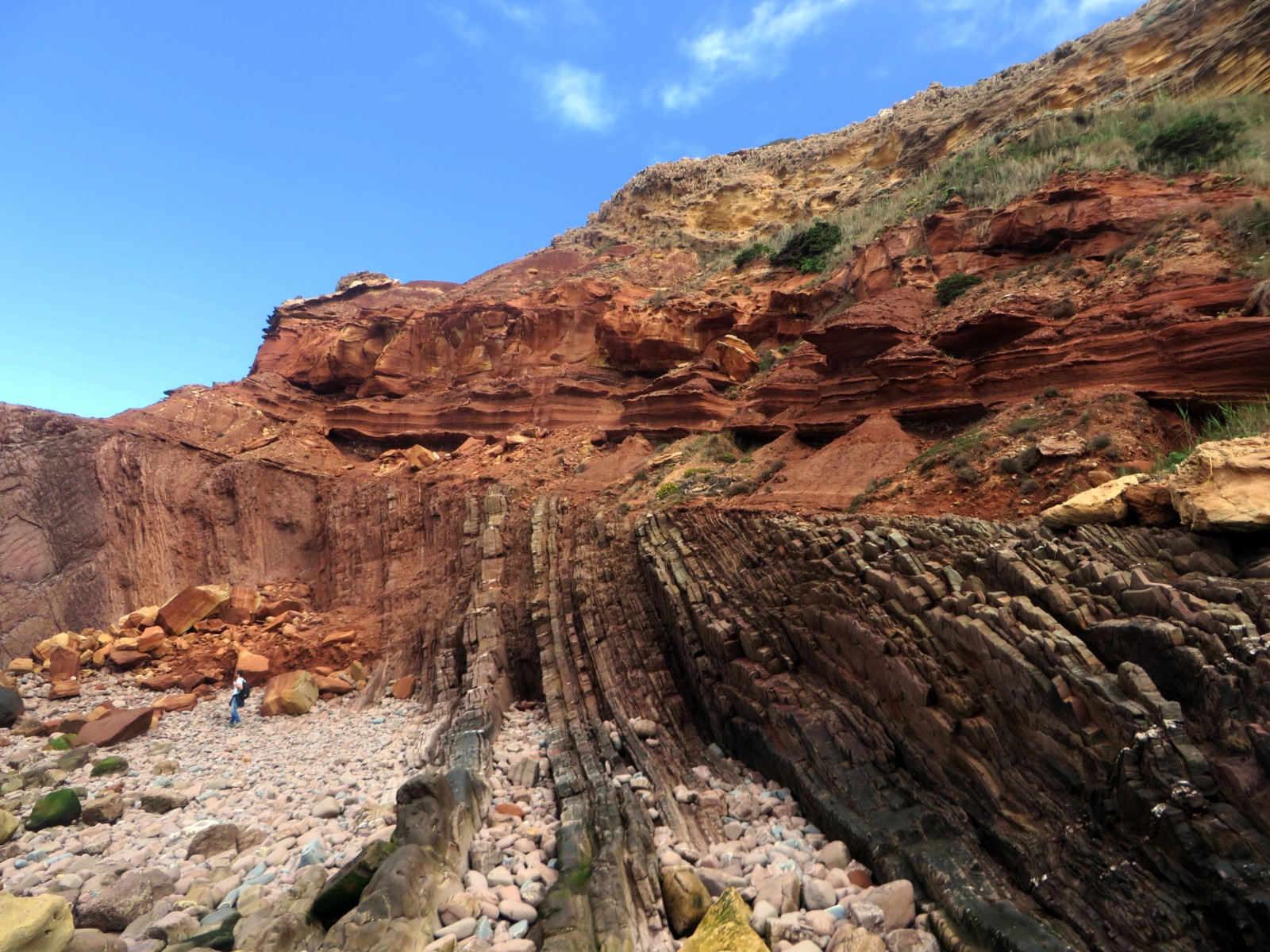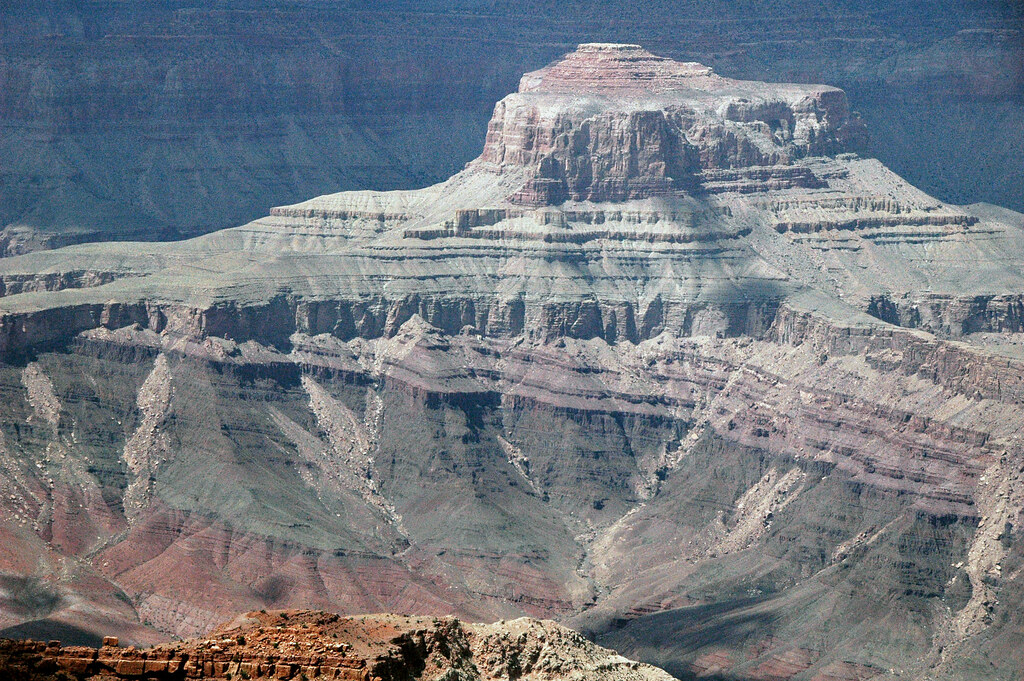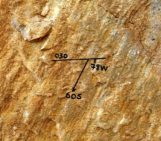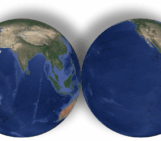
An angular unconformity is an erosional surface that truncates older, tilted sedimentary layers and that is overlain by younger layers, oriented parallel to the unconformity. The discovery and interpretation of angular unconformities, like the famous Hutton’s unconformity at Siccar Point, Scotland, marked a paradigm shift in the geological theories of the 18th century.
At that time, the theory of Neptunism, proposing rocks were the result of crystallization from a primordial ocean, was contraposed to Plutonism: the idea that rocks originated from the crystallization of magma and subsequent weathering, erosion, and deposition as sedimentary layers. Neptunist theories believed Earth formed after a catastrophe, like the mythical flood described in the Genesis. On the other hand, plutonists believed Earth had been, and was being shaped by the same processes that occur today (Uniformitarian Principle).
In 1787-1788, James Hutton, one of the fathers of modern geology, examined a series of angular unconformities in Scotland, including that exposed at Siccar Point. The presence of sedimentary features like ripple marks in the vertical layers beneath the unconformity convinced Hutton that the vertical layers were originally lying horizontally on the seafloor and that were later tilted, eroded, and again submerged, with the deposition of younger layers on top of the unconformity. In 1788, Hutton published a book where he summarized his observations as “we find no vestige of a beginning, no prospect of an end”. With those simple words, Hutton was proposing a new and revolutionary idea – that the world was not the result of a creation or a catastrophic event.

Angular unconformity at Praia do Telheiro, Algarve, Portugal. Here, vertical layers of Carboniferous sandstone and black shale are truncated by horizontal layers of Triassic red sandstone. Deformation of the Carboniferous layers occurred during the Variscan Orogeny. Photo © André Cortesão via Imaggeo.
The original ideas of Hutton on angular unconformities did not change much during the last 250 years, but today we have a better understanding of the processes that shape the Earth’s deep interior and of how these spectacular features originate. Angular unconformities form when original, horizontal layers are deformed, exposed at the surface, eroded away, and then overlain by freshly deposited layers. This cycle usually coincides with a period in which deposition in a basin is interrupted by a deformation event, like the formation of a mountain chain, and requires several millions of years to occur.
Hutton’s unconformity, for instance, marks the closure of a Paleozoic ocean, the Iapetus Ocean, and the Caledonian Orogeny. The tilted layers are roughly 435 million years old, while the sub-horizontal layers, which deposited after the mountains were eroded away, are 370 million years old. A mere 65 million years (which is the time that separates us from the dinosaurs – just to say) is missing from the geological record.

Angular unconformity at the Grand Canyon, between the Cambrian Tonto Group (above) and the Precambrian Grand Canyon Supergroup (below). The time gap here is at least 200 million years. Photo © James St. John via Flickr.
Angular unconformities, like all other unconformities, represent major gaps in the sedimentary record (i.e. a period of erosion and no deposition) and their study is of great importance to reconstruct major tectonic events that occurred in the past. Some unconformities may be also useful for water, oil, and mineral exploration, as these surfaces may mark horizons of increased or decreased porosity, hence control the migration of fluids in the rock mass.
References and further reading.
Hutton, J. (1788). Theory of the Earth; or an investigation of the Laws observable in the Composition, Dissolution, and Restoration of Land upon the Globe. Transactions of the Royal Society of Edinburgh. Royal Society of Edinburgh 1 (Part 2), 209-304.
Shanmugam G. (1988) Origin, Recognition, and Importance of Erosional Unconformities in Sedimentary Basins. In: Kleinspehn K.L., Paola C. (eds) New Perspectives in Basin Analysis. Frontiers in Sedimentary Geology. Springer, New York, NY. https://doi.org/10.1007/978-1-4612-3788-4_5
Video by British Geological Survey – Siccar Point: the Birthplace of Modern Geology.




Graham Cunningham
Siccar Point tells us the Earth is dynamic. Darwin told us life is dynamic. Two greatest contributions of Earth science?
Richard Arrthur BSc FGS
an erosional surface that truncates older, tilted sedimentary layers and that is overlain by younger layers, oriented parallel to the unconformity
My I respectfully suggest you correct this grammatically and geologically to say….
an erosional surface that truncates older, tilted sedimentary layers ‘which are then’ overlain by younger layers. If these younger layers were deposited upon a level unconformity surface they become parallel to that surface and this is called an overstep unconformity. If the younger layers were deposited on a tilted surface. progressive layers can extend over the margin of any preceding layers and this is called an Overlap uncomformity
Samuele Papeschi
Dear Richard,
thank you for your comment. As author, I try to keep the text as simple as possible, so that it is accessible to everyone. I will take your comment into account and try to improve the text in that part. Thank you very much.